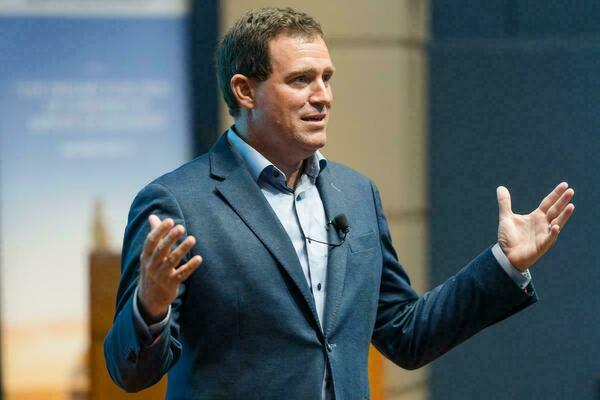Navigating New SEC Climate Disclosure Rules: Insights From Accountancy Professor Sandra Vera-Muñoz

On March 6, 2024, the U.S. Securities and Exchange Commission released new disclosure rules to guide companies on measuring, reporting, and providing assurance on climate-related risks, and to help investors evaluate the impact of these risks on firms’ valuation. While the rules face a raft of complaints, critiques, and legal challenges–with some parties lamenting the rules go too far, and others not far enough–experts are already working to make the rules navigable and actionable. NDDCEL Faculty Fellow Professor Sandra Vera-Muñoz is Associate Professor of Accountancy at the University of Notre Dame’s Mendoza College of Business and has written on the value of transparency in business reporting and the risks associated with not being transparent. She offered her insights on the new rules in an interview with NDDCEL Faculty Director Jessica McManus Warnell.
Key Takeaways
- SEC climate disclosure rules are intended to enhance and standardize climate-related disclosures for business decision-makers and investors.
- The rules, weakened in the face of criticism, eliminate the need for companies to disclose Scope 3 emissions, or those associated with activities up and down the value chain – emissions that can account for the majority of a company’s environmental impacts.
- Most experts agree that the specifics of disclosure requirements will continue to be debated but that demand for measuring and reporting on environmental impacts will only increase as business stakeholders seek transparency.
What are the most important elements of the new SEC rules?
The overarching goal of the rules, as articulated by SEC Chair Gary Gensler, is to provide investors with more consistent, comparable, reliable, and decision-useful climate-related risk information and issuers with clear reporting requirements. It is important to note that investors already expect registrants to disclose financial information that have these key attributes.
A bit of background might be helpful to understand the significance of the SEC’s climate-related disclosure rules’ key provisions. The rules (finalized on March 6, 2024) have been in the works for two years, going back to March 2022 when the SEC issued their proposal and elicited comments from the public. The SEC received a record-setting 24,000 comment letters (over 4,500 unique letters) from investors and other stakeholders, including from some of the world’s biggest industries and influential climate groups.
The final rules will be applied using a phase-in compliance approach based on the registrant’s filer status. For large accelerated filers (LAFs) and accelerated filers (AFs), the rules begin to apply in 2025 and 2026, respectively. For non-accelerated filers (NAFs), emerging growth companies (EGCs), and smaller reporting companies (SRCs), the rules begin to apply in 2027. The rules will require disclosures in Form 10-K, Form 20-F, and registration statements.
Compared to the original proposal, the final rules rely more strongly on the Supreme Court’s definition of materiality and are modeled, at least in part, on the recommendations of the Task Force on Climate-related Financial Disclosures (TCFD). This is important because the rules place material climate-related risks on the same level playing field as any other type of risk – pursuant to Regulation S-K – consistent with the argument that “climate risk is investment risk.” Reliance on the TCFD recommendations is critical because many registrants were already using them for guidance to distinguish between physical risk and transition risk and how to report these risks on regulatory filings.
The final rules strengthen aspects of governance at the board of directors’ (BOD) level. Specifically, registrants will be required to describe the BOD’s oversight of climate-related risks, including board committees or subcommittees for the oversight of these risks, if applicable. Surprisingly, the final rules removed the original proposal’s requirement to describe any climate-related expertise of board members, which seems counterintuitive. The final rules also enhance managers’ responsibilities regarding assessment and management of climate-related risks.
The rules require limited assurance for Scopes 1 and 2 emissions for LAFs and AFs. This requirement will be phased in over multiple years, beginning in 2029 for LAFs and 2031 for Afs – with additional phase-in periods for increasing the level of assurance from limited to reasonable starting in 2033 for LAFs.
After much debate, “Scope 3” emissions are not included in the new regulations – in layperson’s terms, what is meant by Scopes 1, 2, and 3, and why are these distinctions important?
The original SEC proposal would have required registrants to disclose their material direct (Scope 1) and indirect (Scopes 2 and 3) emissions. Many of the comment letters expressed concern about requiring Scope 3 emission disclosures, arguing that these disclosures would be overly burdensome, complex, and costly. Perhaps not surprisingly, the final rules eliminated Scope 3 disclosure requirements. Critics argue, however, that the exclusion of Scope 3 disclosures significantly weakened the final rule.
To understand this argument, it is helpful to understand the distinctions among the three scopes.
- Scope 1 are emissions from burning combustion fuels by stationary (e.g., boilers, furnaces, engines) and mobile (e.g., cars, trucks, vessels, aircraft) assets owned by the entity.
- Scope 2 are emissions generated from energy purchases (e.g., electricity, heating, steam).
- Scope 3 emissions (also referred to as “value chain” emissions) are generated by virtue of an entity’s supply chain (upstream and downstream activities), including transportation, travel, and customers’ use of an entity’s products, such as coal or crude oil.
Importantly, Scope 3 emissions account for roughly 70% of greenhouse gases (GHG) produced by many businesses and even more for companies in the Oil & Gas industry. Many companies have set emission reduction targets that are aligned with the Paris Agreement of 2015 which set global goals of reaching net zero emissions by 2050.
Here is an example: A major Oil & Gas company’s Scope 3 emissions account for roughly 90% of their total emissions. Yet, when they announced their emission reduction targets, they only included their Scopes 1 and 2 emissions, which account for only 10% of their total emissions. Since the final SEC rules do not require companies to disclose their Scope 3 emissions, many companies’ climate-related risk disclosures will likely fail to fully inform investors of the companies’ exposure to material climate risk.
The EU’s disclosure rules are much more stringent, as are some US state-level reporting requirements – do you envision the SEC progressing toward stricter standards in the future?
At one end of the continuum, some critics argue that the SEC’s final rules are too stringent, while at the other end of the continuum critics argue that that the rules are not robust enough, especially when compared with the California climate disclosure laws (SB 253 and SB 261) and the EU’s Corporate Sustainability Reporting Directive (CSRD) rules.
California SB 253 applies to U.S. companies that generate over $1 billion in annual revenues and who are doing business in California. This bill mandates disclosures of all three scopes of GHG emissions and assurance of Scopes 1 and 2 emissions, starting in 2026. California SB 261 applies to U.S. companies that generate over $500 million in annual revenues and who are doing business in California. This bill mandates climate-related financial risk disclosures, starting in 2026.
Europe’s CSRD rules will apply not only to EU-based public interest entities (PIEs) (starting in 2024), but they will also apply to large EU subsidiaries of U.S. parent companies (starting in 2025) and U.S. parent companies with defined business activities in the EU (starting in 2028). Interestingly, the CSRD rules provide a clear requirement to assess double materiality, which takes into account both material impact to investors (i.e., financial materiality) and to other stakeholders (i.e., impact materiality).
Regardless of whether (or how) the current court challenges affect the SEC’s final rules, there is robust research evidence showing that investors and other stakeholders (e.g., customers, employees) rely on material climate-related disclosures for firm valuation, investment decisions, and even whether to work for a company. Therefore, it is in registrants’ best interest to prioritize familiarizing themselves with both the SEC’s new climate-related rules as well as the European rules.
What are the immediate implications of the ruling for business leaders? What are the long-term considerations?
Companies will be required to describe any climate-related risks that have materially impacted or are reasonably likely to have a material impact on the company, including on its strategy, results of operations, and financial condition in the short-term (i.e., next 12 months) and in the long-term (i.e., beyond the next 12 months).
The final SEC rules will require registrants to disclose material climate-related targets or goals, including those related to GHG emission reductions, transition plans for achieving those targets, and annual progress. The rules also require additional disclosures if carbon offsets or renewable energy credits (RECs) are a material component of a registrant’s plan to achieve their climate-related targets.
This is critical because not all carbon offsets are created equal, and some of them either do not reduce GHG emissions (because they do not meet the “additionality” and durability criteria) or may even increase GHG emissions.
The final rules also allow for safe harbors from private liability for forward-looking climate-related disclosures about transition plans, scenario analysis, the use of internal carbon prices, and climate-related targets and goals. Importantly, these safe harbors do not protect companies from liabilities related to disclosures of historical facts.
The new rules require financial statement footnote disclosures on capitalized costs, expenditures, and losses resulting from severe weather events (e.g., wildfires, flooding, hurricanes) if the total amount of all impacts exceeds 1% of equity or net income or loss. The intent here is to provide investors with context for understanding registrants’ forward-looking disclosures. Surprisingly, although the new rules provide examples of severe weather events, they do not define these terms, so it will be up to the registrants to define and contextualize these footnote disclosures.
A Word to Researchers

What the SEC’s new climate-related rules do is to put material climate-related information on the same level playing field as material financial information for investors to use. Will the final rules address critics’ longstanding concerns about “greenwashing”? Or, newer concerns about “greenhushing” (a new term that roughly means the opposite of greenwashing, and that originated as a result of the “anti-ESG” push in the U.S.)?
Research stands to play a very important role in helping answer these (and several other) important questions. There are several other key elements of the final SEC rules and interested readers are encouraged to browse through the SEC’s release to explore its nuances in further detail. And, speaking of research, the SEC final rules are a great example of how academic research can inform policy making. About one-hundred academic studies are cited in the final rule, including two of my articles, co-authored with Ella Mae Matsumura and Rachna Prakash [linked below]. There is much more work to do in this space.
I encourage interested colleagues reading this to submit their work (via email to [email protected]) to the 2024 Accountability in a Sustainable World (ASW) Conference, organized by Mendoza colleague Peter Easton, on or before May 31, 2024.
Along with the ASW Conference, I encourage everyone to engage with Accountability in a Sustainable World Quarterly, which publishes insightful and provocative articles written by academic and thought leaders in the sustainability space. ASWQ is also a great resource for academics teaching sustainability-related graduate and undergraduate courses.
For Further Reading:
For more on Professor Vera-Muñoz’s work on ESG/sustainability reporting and insights from industry leaders, see our feature on how transparency sets your firm apart.
- SEC Adopts Rules to Enhance and Standardize Climate-Related Disclosures for Investors
- SEC Scales Back New Pollutions-Disclosure Rules for Companies
- For CFOs Tackling Weakened SEC Climate Rule, Cost Challenges Persist
- The SEC Released a New Climate Rule. The Fight Is Just Beginning.
- Five Takeways from the SEC’s New Climate-Related Disclosure Rule
Selected Faculty Publications:
E.M. Matsumura, R. Prakash, and S.C. Vera-Muñoz, “Firm-value effects of carbon emissions and carbon disclosures,” The Accounting Review (89/2) March, 2014, 695-724.
E.M. Matsumura, R. Prakash, and S.C. Vera-Muñoz, “Climate-risk materiality and firm risk,” Review of Accounting Studies (September 2022), published online.
This article was written by Lindsay Paturalski, and published in March 2024. For more information visit the Deloitte Center for Ethical Leadership website.
More Like This
Related PostsLet your curiosity roam! If you enjoyed the insights here, we think you might enjoy discovering the following publications.








